20 Best Native Plants for Connecticut
BY KIMBERLY MAGERL | MAY 12TH, 2023 | CONNECTICUT, LAWN CAREConnecticut is a small state that has a lot to offer. It is home to beautiful fall foliage, picturesque forests, breathtaking lakes, and silvery beaches. Invite some of the Constitution State’s rich and natural history into your landscape by filling your yard with some of the best native plants in Connecticut.
Native plants offer many landscaping benefits, including:
- Native plants support a diverse ecosystem, providing food and shelter for local wildlife, birds, and insects.
- They are acclimated to the humid continental climate and four distinct seasons.
- They are low-maintenance, surviving Connecticut winters, local insects, and disease.
Native plants promote a healthier Connecticut ecosystem and assist important conservation efforts. Check out these 20 native plants to help you plan your natural landscape.
In this article, we’ll cover:
- 20 Native Plants for Your Connecticut Yard
- Bearberry
- Butterfly Weed
- Canada Goldenrod
- Cardinal Flower
- Cranberry Viburnum
- Eastern White Oak
- Little Bluestem
- Marsh Marigold
- Mountain-Laurel
- Narrow-Leaf Mountain Mint
- New England Aster
- Pearly Everlasting
- Red Chokeberry
- Redosier Dogwood
- Swamp Azalea
- Swamp Milkweed
- Sweet Pepperbush
- Trumpet Honeysuckle
- Wild Red Columbine
- Winterberry
- How to Choose Native Plants for Your Connecticut Landscape
- FAQ About Native Connecticut Plants
- Where to Find Native Plants in Connecticut
20 Native Plants for Your Connecticut Yard
1. Bearberry (Arctostaphylos uva-ursi)

Photo Credit: Andrew Curtis / Wikimedia Commons / CC BY-SA 2.0
Bearberry, also known as kinnikinick, is a low-growing shrub that grows well in fabricated gardens, slopes, banks, sandy soils, and rocks throughout Connecticut. Trailing evergreen branches with papery red bark and shiny paddle-shaped leaves creep across exposed rocks, forming dense mats.
Bearberry blooms clusters of small, bell-shaped white and pink flowers in the spring that give way to bright red berries that last into winter, attracting birds and wildlife. It is a hardy and slow-growing shrub that is salt-tolerant and has no pest or disease problems. It is beneficial to local bees and the larval host of the Hoary and Brown Elfin and Freija Fritillary butterflies.
Growth habit: Shrub
USDA hardiness zone: 2-6
Mature size: 6-12 inches tall and 15 inches in diameter
Duration: Perennial
Foliage: Evergreen
Sunlight needs: Full sun, partial shade, full shade
Soil preferences: Adaptable; dry or moist, acidic, sandy or rocky soils
Water needs: 1 inch of rainfall or water per week
Potential hazards: Non-toxic; edible; tasteless; preferred by animals
2. Butterfly Weed (Asclepias tuberosa)
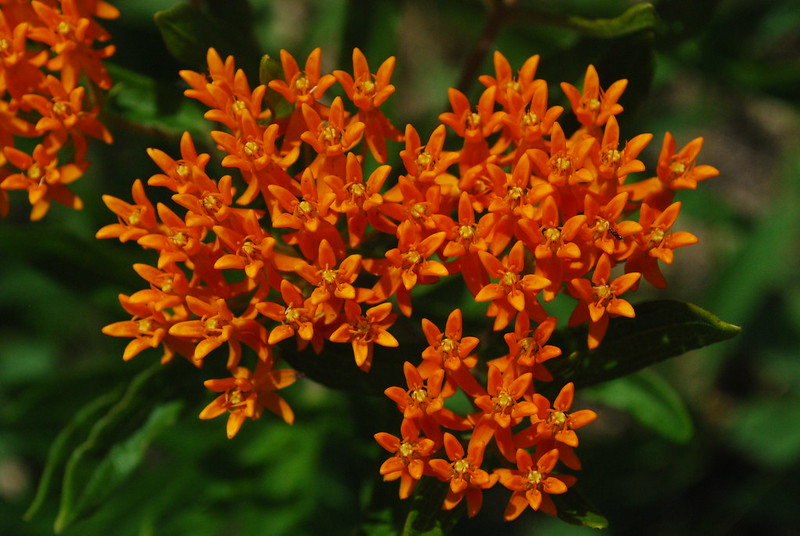
Photo Credit: Joshua Mayer / Flickr / CC BY-SA 2.0
Butterfly weed is a native species of milkweed and is extremely important to healthy Connecticut landscapes and conservation efforts. It is an attractive flowering plant, a nectar source for bees and native pollinators, and a host plant for caterpillars, including Monarch, Gray Hairstreak, and Queen butterflies. There are three native species of milkweed wildflowers that grow throughout the Constitution State.
Butterfly weed produces bright orange or yellow flowers from summer to fall. The attractive plant is hardy and loves full sun. It tolerates most soils but prefers sandy well-draining soil and is moderately drought-tolerant. It makes a great addition to flower beds, pollinator gardens, meadows, and cut flower arrangements.
Growth habit: Herb
USDA hardiness zone: 3-10
Mature size: 1-4 feet tall and less than 1 foot wide
Duration: Perennial though some species are annuals
Foliage: N/A
Sunlight needs: Full sun
Soil preferences: Prefers dry, sandy soil or gravel
Water needs: Semi drought-tolerant; prefers to dry out between waterings
Potential hazards: Low toxicity; milky sap irritates humans and animals
3. Canada Goldenrod (Solidago canadensis)
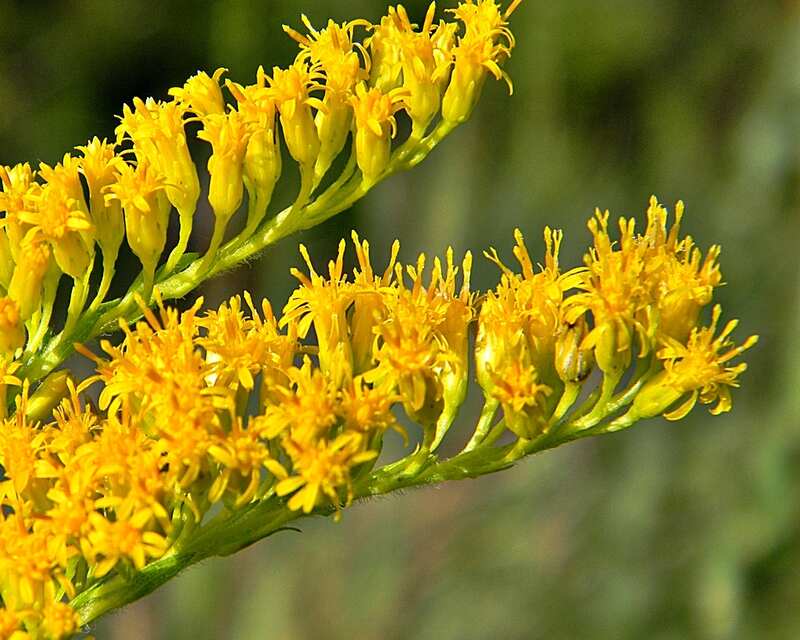
Photo Credit: Bob Peterson / Wikimedia Commons / CC BY-SA 2.0
Canada goldenrod is a member of the aster family. Also known as giant goldenrod, this herbaceous perennial reaches heights up to 6 feet. Canada goldenrod has fine, leafy stems with tiny yellow flowers on arching branches. Plant specimens in meadows, prairies, pastures, garden beds, and along stream banks.
Canada goldenrod blooms in late summer through September, attracting honey bees and local pollinators. It grows well in a range of soils and does not require additional watering outside of natural rainfall. The low-maintenance aster grows throughout the state and is commonly seen growing alongside highways, rural routes, forests, and shorelines.
Growth habit: Herb
USDA hardiness zone: 3-9
Mature size: Up to 6 feet tall
Duration: Perennial
Foliage: Semi-evergreen
Sunlight needs: Full sun to partial shade
Soil preferences: Adaptable; dry or moist, caliche, sandy, sandy-loam, medium-loam, clay-loam, or clay soils
Water needs: Drought tolerant; only water during drought conditions when soil is completely dry
Potential hazards: Toxic; contains poisonous saponins
4. Cardinal Flower (Lobelia cardinalis)
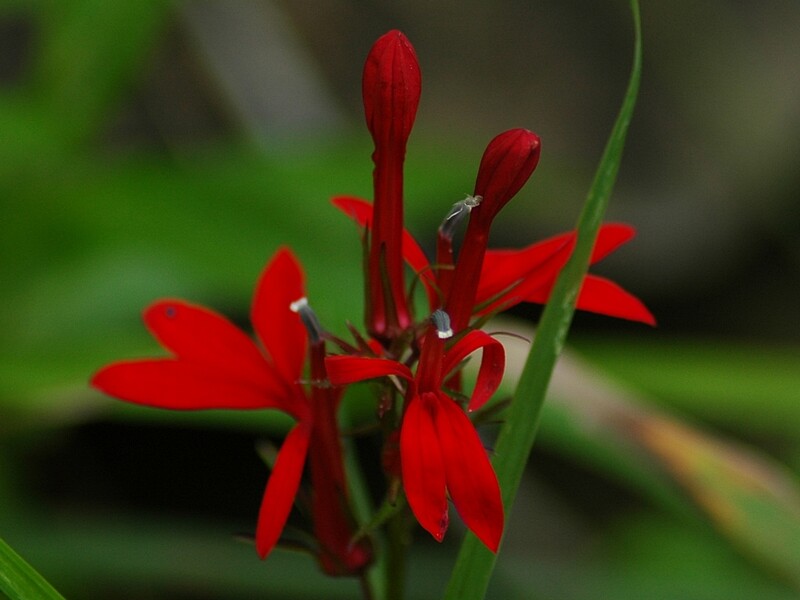
Photo Credit: linnaeus / Wikimedia Commons / CC BY-SA 3.0
Cardinal flower is a showy perennial with bright red, tubular flowers that bloom from May to October. Its unique blooms have spreading lower petals with two upper petals that unite into a tube at the base atop erect stems with pointy leaves.
Cardinal flowers reach heights up to 6 feet tall. The moisture-loving herbaceous plant grows along the edges of ponds and streams, tolerating occasional flooding. It makes a great addition to rain and pollinator gardens, flower beds, and along the edges of woodlands. Its blooms attract hummingbirds, butterflies, and other pollinators.
Growth habit: Herb
USDA hardiness zone: 2-9
Mature size: Up to 6 feet tall
Duration: Perennial
Foliage: Evergreen
Sunlight needs: Full sun, partial shade, full shade
Soil preferences: Prefers moist to wet, rich, medium loam, clay-loam, limestone, sandy, sandy-loam, or clay soils
Water needs: Prefers moist soil; water deeply twice per week during hot months
Potential hazards: Toxic; poisonous to humans and animals if consumed in large quantities
5. Cranberry Viburnum (Viburnum opulus)
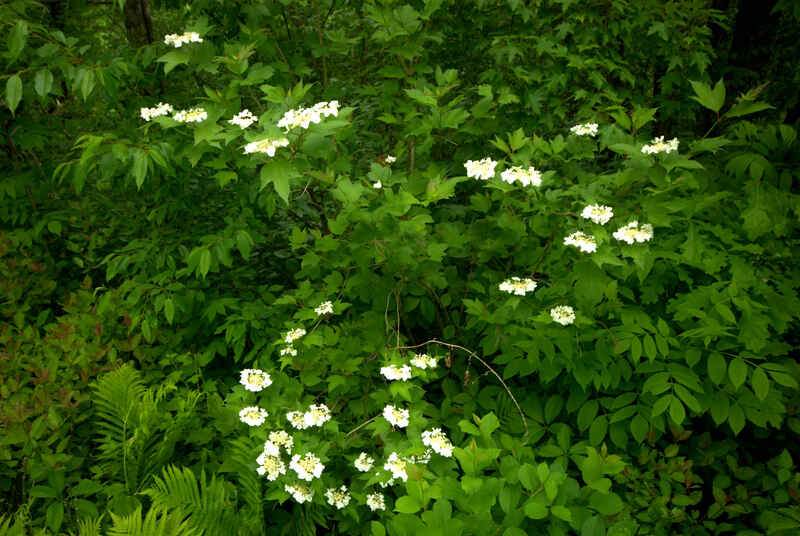
Photo Credit: Joshua Mayer / Flickr / CC BY-SA 2.0
Cranberry viburnum is a hardy deciduous shrub. It is flood, disease, and insect tolerant. The flowering perennial has a dense growth habit with arching branches and a round outline. It has maple-shaped leaves that turn vibrant shades of red, orange, yellow, and burgundy in the fall.
Cranberry viburnum grows along slopes, rocky shores, and in shady woods. It blooms clusters of small white flowers in the spring followed by bright red edible fruits that persist through winter. The hardy shrub attracts songbirds, game birds, small mammals, and butterflies. It is the larval host of the Spring Azure butterfly. Plant this dense shrub along forest edges and in hedgerows.
Growth habit: Shrub
USDA hardiness zone: 2-7
Mature size: 6-12 feet tall
Duration: Perennial
Foliage: Deciduous
Sunlight needs: Partial shade
Soil preferences: Moist or wet, well-drained loam
Water needs: Water 1 inch per week during dry conditions
Potential hazards: Non-toxic; edible though may cause discomfort if consumed in large quantities
6. Eastern White Oak (Quercus alba)
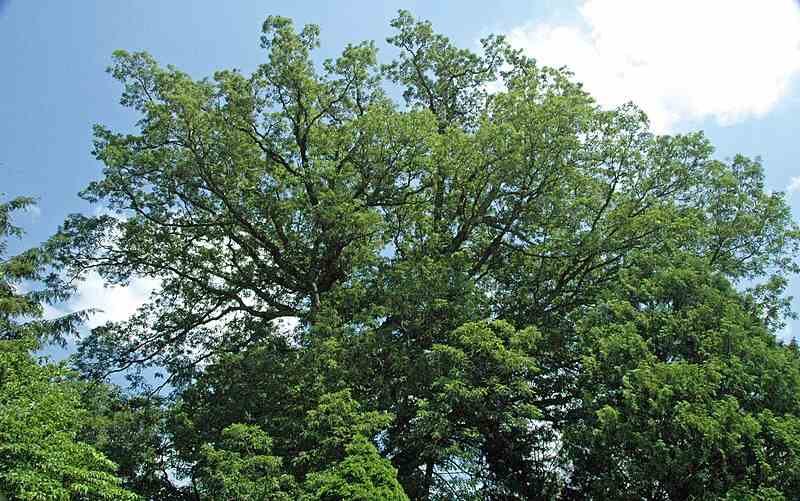
Photo Credit: James St. John / Wikimedia Commons / CC BY 2.0
Eastern white oak is deeply rooted in Connecticut tradition. It is the state tree and a popular shade tree with a long lifespan. It is a large tree, growing upwards of 100 feet or more and 60 to 80 feet wide. These trees have rounded, widespread crowns, scaly gray-brown bark, and gray-red twigs.
Eastern white oaks produce recognizable lobed leaves that turn burgundy in the fall. The grand deciduous tree is one of the most important oak species, and its wood is used to make furniture, flooring, and other items like wine and whiskey barrels. Its fall acorn fruits attract birds, small mammals, and deer. Plant this shade tree in large back or front yards with ample space. Just be sure to note the deciduous tree drops its leaves in late fall.
Growth habit: Tree
USDA hardiness zone: 3-9
Mature size: Up to 100+ feet tall and 60-80 feet wide
Duration: Perennial
Foliage: Deciduous
Sunlight needs: Full sun, partial shade, full shade
Soil preferences: Adaptable; dry or moist, deep, acidic, well-drained, loam, sand, sand-loam, medium-loam, clay-loam, or clay soils
Water needs: Do not require watering outside of natural rainfall
Potential hazards: Non-toxic; no safety hazards
7. Little Bluestem (Schizachyrium scoparium)
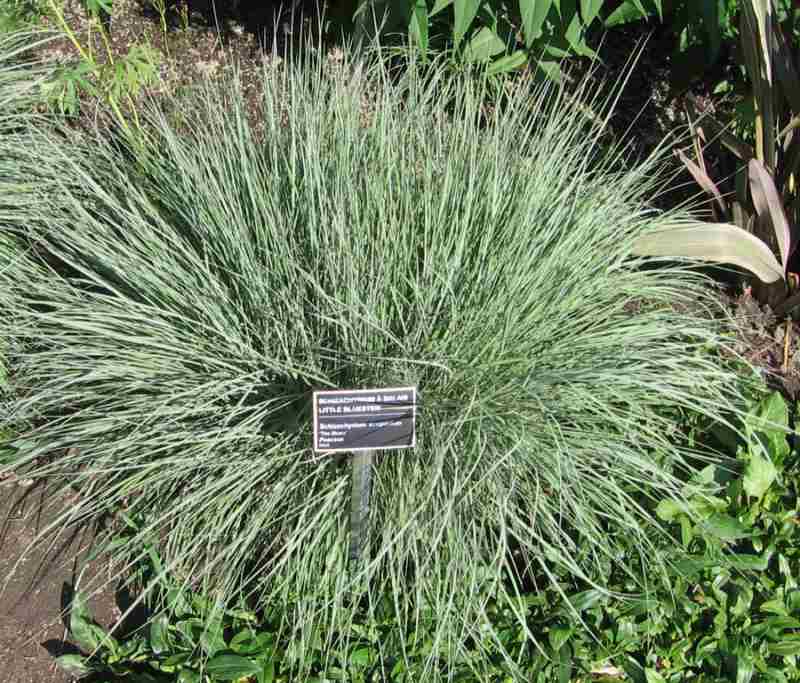
Photo Credit: Montrealais / Wikimedia Commons / CC BY 3.0
Little bluestem is an ornamental bunchgrass. It forms dense mounds of fine-textured, blue-green foliage. The grass turns shades of vibrant mahogany with cottony white seed tufts in the fall. Little bluestem is important to Connecticut’s ecosystem, attracting native songbirds in the winter.
The ornamental grass is the larval host of many butterflies and moths, including the Ottoe, Indian, Crossline, Dixie, and Dusted Skippers and the Cobweb butterfly. Little bluestem adapts to a range of soil types so long as the space is dry and well-drained. Plant the attractive grass in mass plantings for a great fall visual, along the edges of woodlands, on slopes, or in large flower beds. Little bluestem reseeds itself, making it ill-suited for confined spaces.
Growth habit: Grass
USDA hardiness zone: 3-9
Mature size: 18-24 inches tall and 12 inches in diameter, can reach up to 5 feet tall a
Duration: Perennial
Foliage: N/A
Sunlight needs: Full sun to partial shade
Soil preferences: Adaptable; dry, well-drained, sand, sand-loam, medium-loam, clay-loam, clay, or limestone soil
Water needs: Drought-tolerant; only water during drought conditions when soil is completely dry
Potential hazards: Non-toxic; no safety hazards
8. Marsh Marigold (Caltha palustris)

Photo Credit: Judy Gallagher / Wikimedia Commons / CC BY 2.0
Marsh marigold is an herbaceous succulent with thick, heart-shaped leaves and branching stems. Bright yellow, five-petaled flowers bloom in showy clusters in the spring. Marsh marigold is a mounding perennial plant, reaching up to 2 feet tall.
The deciduous succulent’s blooms closely resemble buttercups, attracting birds and local bees. It is a low-maintenance plant that loves moist soils, woodlands, marshes, and stream edges. Grow marsh marigolds in a moist shady spot as part of natural landscapes, mass planting, or specimen plantings.
Growth habit: Herb
USDA hardiness zone: 3-7
Mature size: 1-2 feet tall
Duration: Perennial
Foliage: Deciduous sometimes evergreen
Sunlight needs: Partial shade to full shade
Soil preferences: Moist to wet, muddy, rich soil
Water needs: Prefers moist soil; water deeply twice per week during hot months
Potential hazards: Toxic; raw leaves contain protoanemonin and are poisonous to humans and animals, including livestock
9. Mountain-Laurel (Kalmia latifolia)
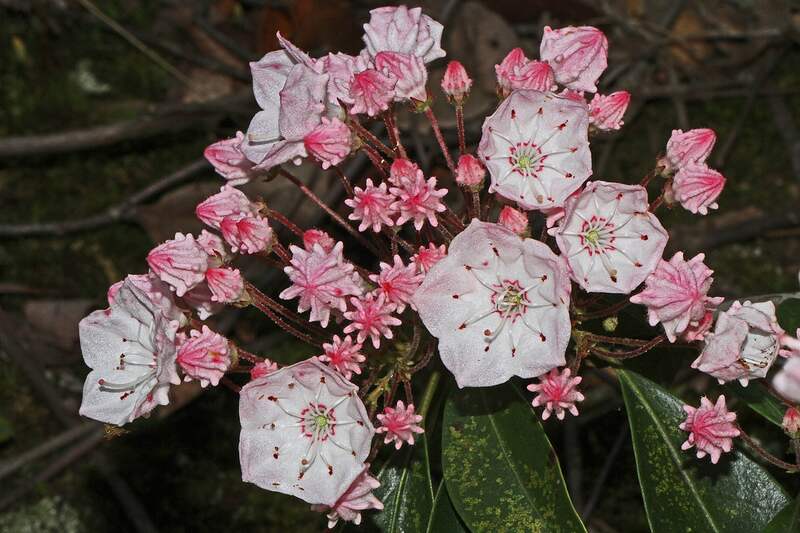
Photo Credit: Judy Gallagher / Wikimedia Commons / CC BY 2.0
Mountain-laurel is an evergreen, multi-trunked shrub that can grow up to 30 feet tall. It is Connecticut’s state flower and typically ranges between 10 to 15 feet tall with dense, glossy, dark green leaves. Fragrant lavender or pink flowers, reminiscent of the smell of grape Kool-Aid, bloom in drooping clusters from February to April, followed by semi-woody pods full of red poisonous seeds.
The ornamental shrub is slow-growing, deer-resistant, and drought-tolerant. Mountain-laurel thrives in rocky soils and responds well to pruning. Plant this showy evergreen as part of an animal-free landscape and pollinator garden to attract butterflies.
Growth habit: Shrub
USDA hardiness zone: 5-9
Mature size: 10-15 feet tall
Duration: Perennial
Foliage: Evergreen
Sunlight needs: Full sun to partial shade
Soil preferences: Drought-tolerant; adaptable; dry or moist, well-drained, rock, sand, sand-loam, medium-loam, clay-loam, or clay soils
Water needs: Does not require additional water outside of nature rainfall unless dry weather persists for a week or more
Potential hazards: Toxic; all parts are poisonous to humans and animals; potentially fatal
10. Narrow-Leaf Mountain Mint (Pycnanthemum tenuifolium)
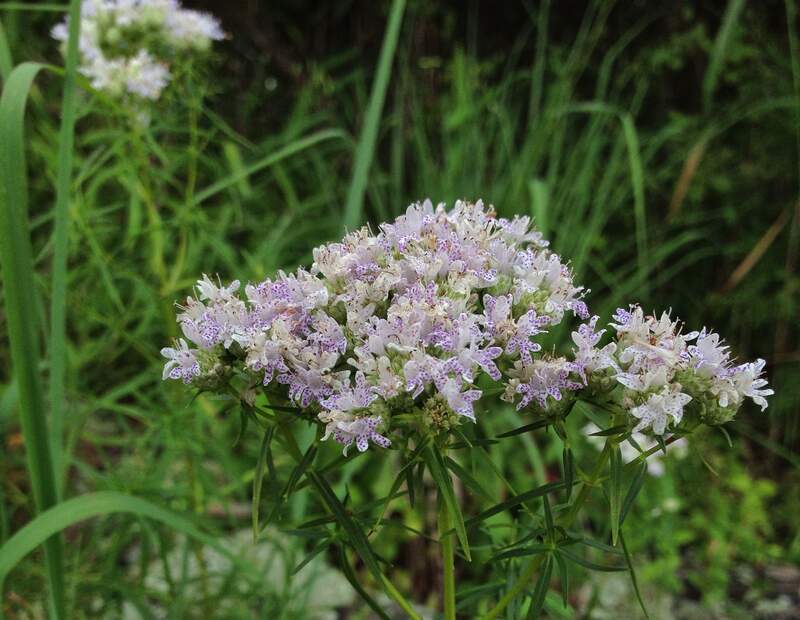
Photo Credit: Fritzflohrreynolds / Wikimedia Commons / CC BY-SA 3.0
Narrow-leaf mountain mint is a compact member of the mint family. Its aromatic and narrow leaves form clumps up to 4r feet tall in rich soil conditions. Clusters of white and lavender flowers bloom in the summer through September, attracting butterflies and honey bees.
Narrow-leaf mountain mint attracts deer, small mammals, game birds, and songbirds. It makes a great addition to naturalized landscapes, low-maintenance flower beds, and rain gardens, though it spreads rapidly.
Growth habit: Herb
USDA hardiness zone: 4-8
Mature size: 2-4 feet tall
Duration: Perennial
Foliage: N/A
Sunlight needs: Full sun to partial shade
Soil preferences: Adaptable; dry to moist, acidic soils
Water needs: Allow the soil to dry out between waterings; responds best to drip irrigation
Potential hazards: Non-toxic; edible; leaves can be made into tea or rubbed onto skin as a natural mosquito repellent
11. New England Aster (Symphyotrichum novae-angliae)
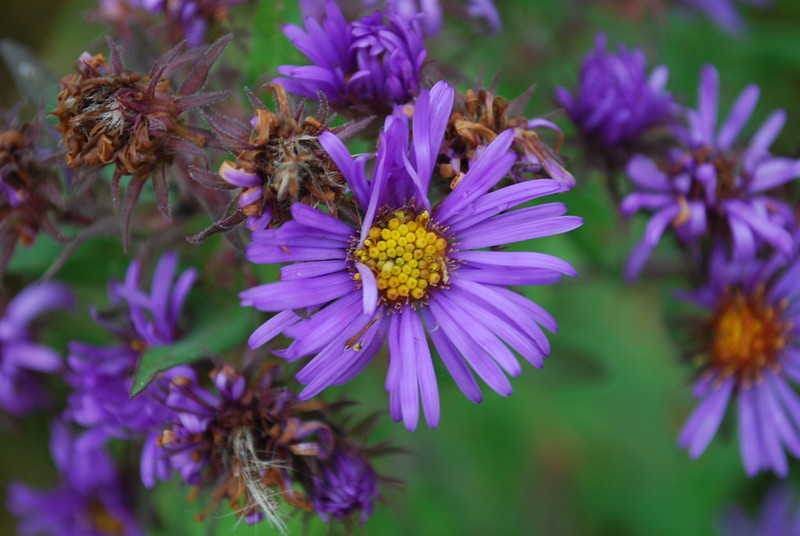
Photo Credit: Joshua Mayer / Flickr / CC BY-SA 2.0
New England asters are vibrant perennial flowers with showy blooms and a persistent, sometimes aggressive growth habit. The herbaceous flowers produce large purplish-pink blooms with slender petals around a bright yellow center. It has leafy branches that reach up to 6 feet tall and bright green, hairy leaves.
New England aster is commonly found in rocky soils, stream banks, moist wooded areas, and mesic prairies. It prefers partial shade, is an important Connecticut pollinator, and is the larval host for the Pearl Crescent butterfly. Plant New England asters in large garden beds, rocky areas, or naturalized landscapes where they have room to spread and enjoy their blooms from August to November or until frost.
Growth habit: Herb
USDA hardiness zone: 4-8
Mature size: Up to 6 feet tall
Duration: Perennial
Foliage: N/A
Sunlight needs: Partial shade
Soil preferences: Adaptable; prefer moist soils
Water needs: Water once or twice weekly in place of regular rainfall to ensure evenly moist soil
Potential hazards: Non-toxic; edible
12. Pearly Everlasting (Anaphalis margaritacea)
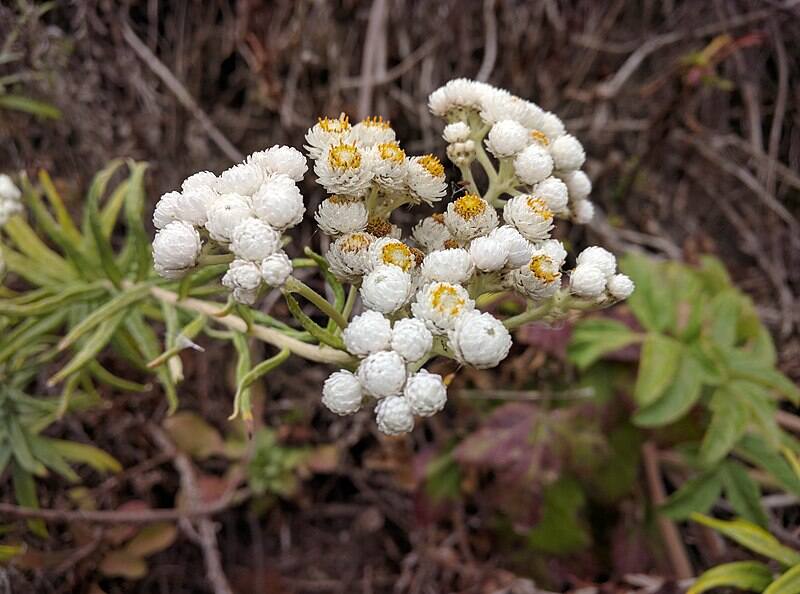
Photo Credit: Franco Folini / Wikimedia Commons / CC BY-SA 2.0
Pearly everlasting is another member of the aster family with smaller blooms. It is an erect, herbaceous perennial with soft, cottony stems and a bushy appearance. Pearly everlasting has narrow, grayish-green leaves. The unique flowering plant produces clusters of small pearl-white flowers from June to October.
Pearly everlasting is an attractive pollinator and the food source and larval host plant for Painted Lady butterflies. It grows best in full sun and dry, rocky soils. It is often found in open woods, dry prairies, and along Connecticut roadsides. Plant pearly everlasting in large garden beds, open rocky areas, and naturalized landscapes.
Growth habit: Herb
USDA hardiness zone: 3-7
Mature size: Up to 3 feet tall
Duration: Perennial
Foliage: N/A
Sunlight needs: Full sun to partial shade
Soil preferences: Dry, sand or gravel soils
Water needs: Drought-tolerant; does not require water outside of natural rainfall; water a maximum of twice per month in the summer
Potential hazards: Non-toxic; no safety hazards
13. Red Chokeberry (Aronia arbutifolia)
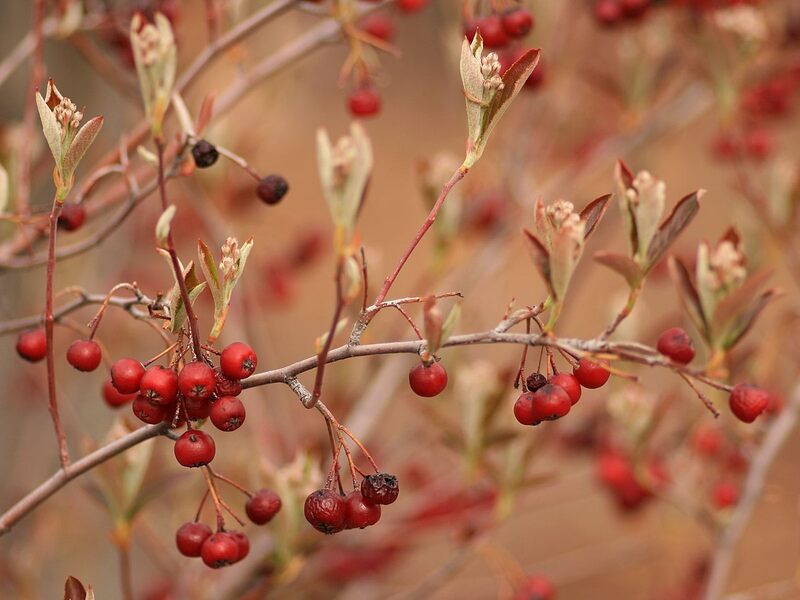
Photo Credit: Katja Schulz / Wikimedia Commons / CC BY 2.0v
Red chokeberry is a multi-trunked shrub and member of the rose family providing four-season interest for Nutmeggers. White, five-petaled flowers bloom in the spring, giving way to glossy dark green leaves all summer. The leaves turn rich shades of orange and red in the fall and bright red, pear-shaped berries bloom until January.
Plant red chokeberry as part of your natural landscape to form a close-knit colony. These multi-seasonal shrubs make great border plants. They prefer full sun and adapt to a range of soil types.
Growth habit: Shrub
USDA hardiness zone: 4-9
Mature size: 6-10 feet tall and 3-5 feet wide
Duration: Perennial
Foliage: Deciduous
Sunlight needs: Prefer full sun; partial shade
Soil preferences: Adaptable; moist to dry, rich soils
Water needs: Does not require additional water outside of nature rainfall unless dry weather persists for a week or more
Potential hazards: Non-toxic; edible
14. Redosier Dogwood (Cornus sericea)
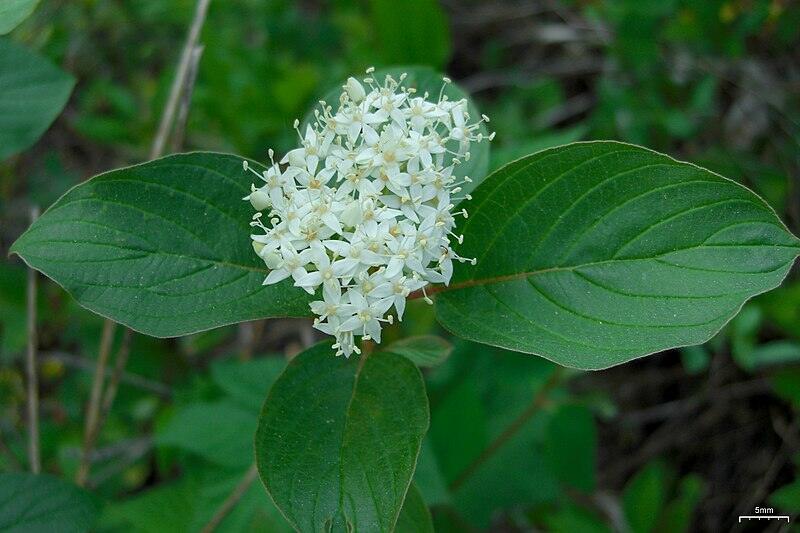
Photo Credit: Jason Hollinger / Wikimedia Commons / CC BY 2.0
Redosier dogwood is a spreading shrub with a loose growth habit and attractive red twigs. It reaches heights up to 12 feet tall, blooming clusters of white flowers that give way to umbrella-shaped white berries from May through October. Redosier dogwood keeps its leaves through fall, which turn shades of red, orange, yellow, and burgundy.
The attractive shrub provides many ecological benefits to Connecticut’s landscapes. Preferring partial sun, redosier dogwood makes a great addition to wet areas, river banks, lake and pond shores, and wooded or open landscapes. It is the larval host for the Spring Azure butterfly and attracts waterfowl, marshbirds, shorebirds, and large and small mammals such as deer and squirrels.
Growth habit: Shrub
USDA hardiness zone: 2-7
Mature size: Up to 12 feet tall
Duration: Perennial
Foliage: Deciduous
Sunlight needs: Partial Shade
Soil preferences: Adaptable; moist, well-drained soils
Water needs: Does not require additional water outside of nature rainfall unless dry weather persists for a week or more
Potential hazards: Non-toxic; no safety hazards
15. Swamp Azalea (Rhododendron viscosum)
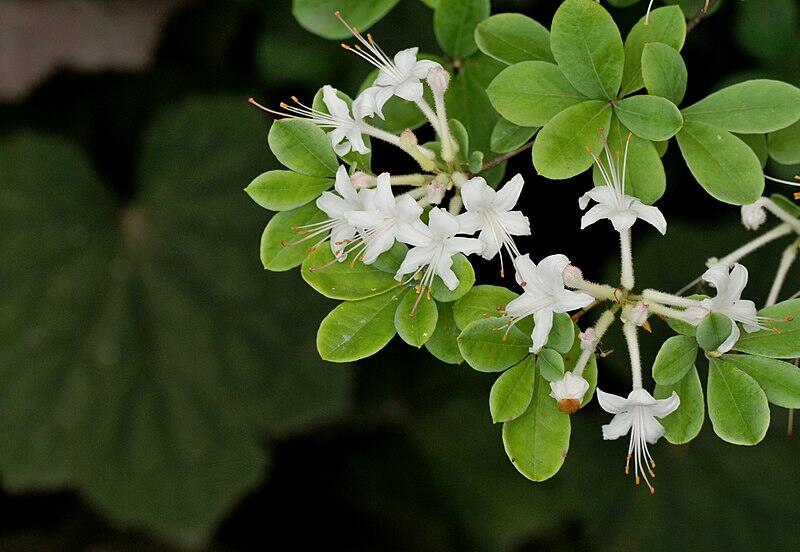
Photo Credit: HorsePunchKid / Wikimedia Commons / CC BY-SA 4.0
Swamp azalea, also known as clammy azalea, is an important coastal Connecticut pollinator. Originating near wetlands, streams, rivers, and lakes throughout the state, this loose-growing deciduous shrub blooms fragrant white to light pink flowers. Its vibrant spring blooms attract pollinating insects, while the dried stalks provide shelter for songbirds in the winter.
Swamp azaleas prefer dappled shade and thrive in the well-drained, rich, moisture-retaining soils found throughout the state. Plant these beautiful blooms as part of mass plantings, woodland gardens, mixed borders, and pollinator gardens. Swamp azalea is one of two native azalea species.
Growth habit: Shrub
USDA hardiness zone: 3-9
Mature size: 5 feet tall; can reach up to 15 feet tall
Duration: Perennial
Foliage: Deciduous
Sunlight needs: Partial shade
Soil preferences: Wet, acidic soil
Water needs: Does not require additional water outside of nature rainfall unless dry weather persists for a week or more
Potential hazards: Toxic; poisonous if consumed in large quantities
16. Swamp Milkweed (Asclepias incarnate)
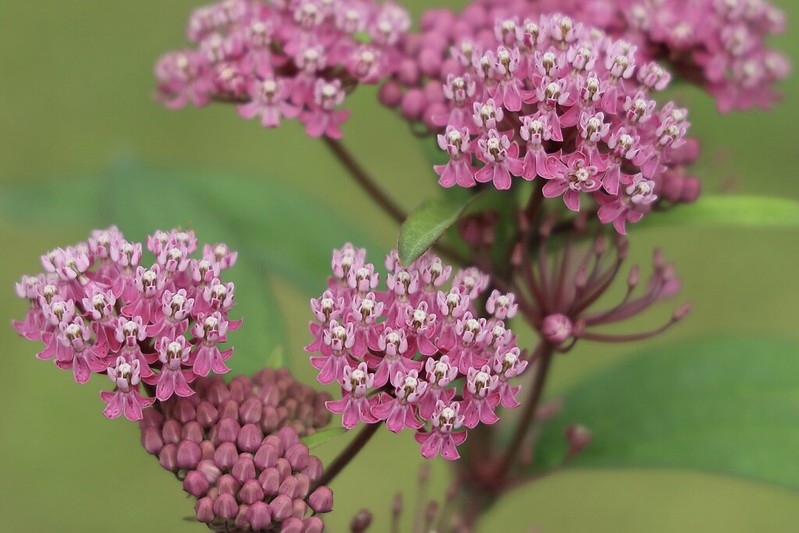
Photo Credit: Lydia Fravel / Flickr / CC BY 2.0
Swamp milkweed is another important pollinator plant for coastal and wetland Connecticut. Like butterfly weed, it is an herbaceous perennial producing vibrant blooms from June through October. The showy plant blooms small pinkish-purple flowers in tight clusters atop long, branching stems with narrow leaves.
Swamp milkweed has an erect growth habit. It is flood-tolerant and loves moist soils. Like all milkweeds, it is an important host plant and food source for the Monarch and Queen butterflies. Sew this plant from seed in moist landscapes, low areas prone to flooding, moist flower beds, or on the banks of a pond where it will thrive in the muddy clay soil.
Growth habit: Herb
USDA hardiness zone: 3-6
Mature size: Up to 5 feet tall
Duration: Perennial
Foliage: N/A
Sunlight needs: Full sun to partial shade
Soil preferences: Moist to wet, rich, muddy, acidic, clay soils
Water needs: Flood-tolerant; prefers moist soil; does not require water outside of natural rainfall except in the fall or during extreme dry periods
Potential hazards: Non-toxic; no safety hazards
17. Sweet Pepperbush (Clethra alnifolia)
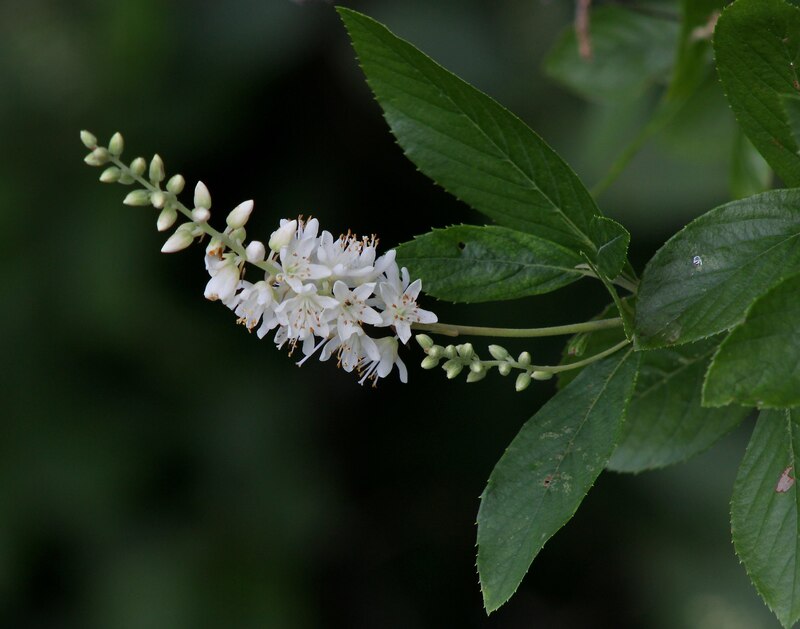
Photo Credit: Under the same moon… / Wikimedia Commons / CC BY 2.0
Sweet pepperbush, also known as summersweet, is an attractive landscape shrub producing visual interest no matter the season. The deciduous perennial produces shiny green leaves in the spring, spiky pink or white flowers in the summer, yellow leaves in the fall, and delicate seed capsules that attract birds and small mammals in the winter.
Sweet pepperbush grows statewide. It has an open growth pattern and soft texture. The fragrant shrub prefers partial shade and makes a great addition to pollinator gardens, natural landscapes, and mixed borders.
Growth habit: Shrub
USDA hardiness zone: 4-9
Mature size: 3-8 feet tall
Duration: Perennial
Foliage: Deciduous
Sunlight needs: Partial shade
Soil preferences: Adaptable; prefers acidic, moist, well-drained soil
Water needs: Does not require additional water outside of nature rainfall unless dry weather persists for a week or more
Potential hazards: Non-toxic; no safety hazards
18. Trumpet Honeysuckle (Lonicera sempervirens)

Photo Credit: Matt Lavin / Flickr / CC BY-SA 2.0
Trumpet honeysuckle, or coral honeysuckle, is a twining evergreen clumping vine found climbing the woodlands, forest borders, and roadway banks of Connecticut. It blooms from spring through summer. You can find it crawling trellises, walls, and fences, reaching heights up to 18 feet.
Trumpet-shaped red-orange flower clusters grow among dark, shiny leaves, giving way to bright red berries from September to October. Trumpet honeysuckle attracts hummingbirds, songbirds, and other pollinators with its vibrant flowers and fruit.
Growth habit: Vine
USDA hardiness zone: 4-10
Mature size: 3-18 feet
Duration: Perennial
Foliage: Evergreen to semi-evergreen
Sunlight needs: Full sun to partial shade
Soil preferences: Adaptable; prefers well-drained soil
Water needs: Does not require additional water outside of nature rainfall unless dry weather persists for a week or more
Potential hazards: Toxic; poisonous to humans and animals if ingested
19. Wild Red Columbine (Aquilegia canadensis)
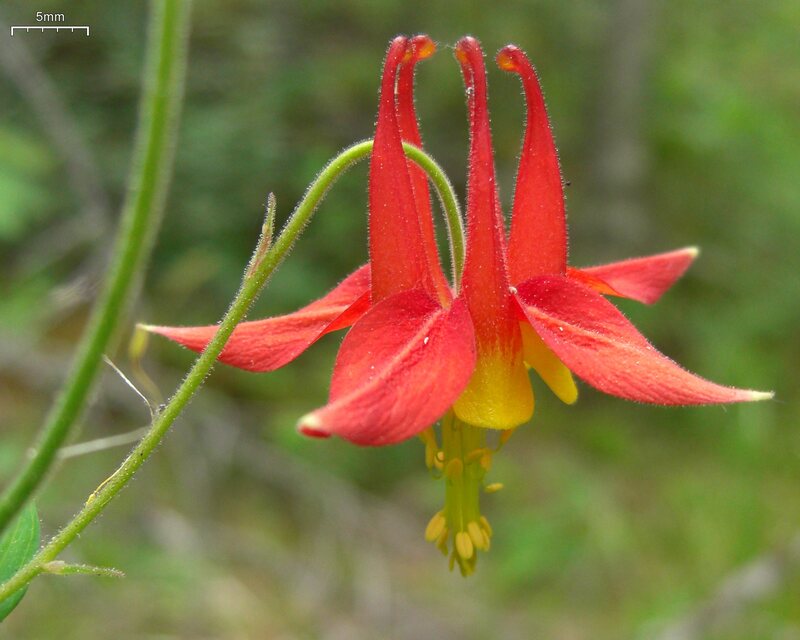
Photo Credit: Jason Hollinger / Wikimedia Commons / CC BY 2.0
Wild red columbine is a perennial herb and a member of the buttercup family. This Connecticut native grows up to 3 feet tall with showy, tuberous red and yellow blooms that droop, exposing bright yellow stamens. Find this herbaceous flower growing in rich forests and woodlands and along cliffs, river shores, and rocky banks.
Wild columbine has an erect growth pattern and bright green leaves. Its flowering tubes attract hummingbirds and butterflies and rabbits love to munch on its foliage. This perennial prefers partial shade. Wild red columbine struggles when other plants compete with its root systems and prefer to grow alone as a groundcover in flower beds, at the edges of gardens, or in containers.
Growth habit: Herb
USDA hardiness zone: 3-8
Mature size: 1-4 feet tall
Duration: Perennial
Foliage: Semi-evergreen
Sunlight needs: Full sun to full shade; prefers partial shade
Soil preferences: Prefers neutral, sandy, well-drained sand, medium loam, sandy loam, or limestone-based soil
Water needs: Drought-tolerant; does not require additional water outside of nature rainfall unless dry weather persists for a week or more
Potential hazards: Non-toxic; no safety hazards
20. Winterberry (Ilex verticillata)
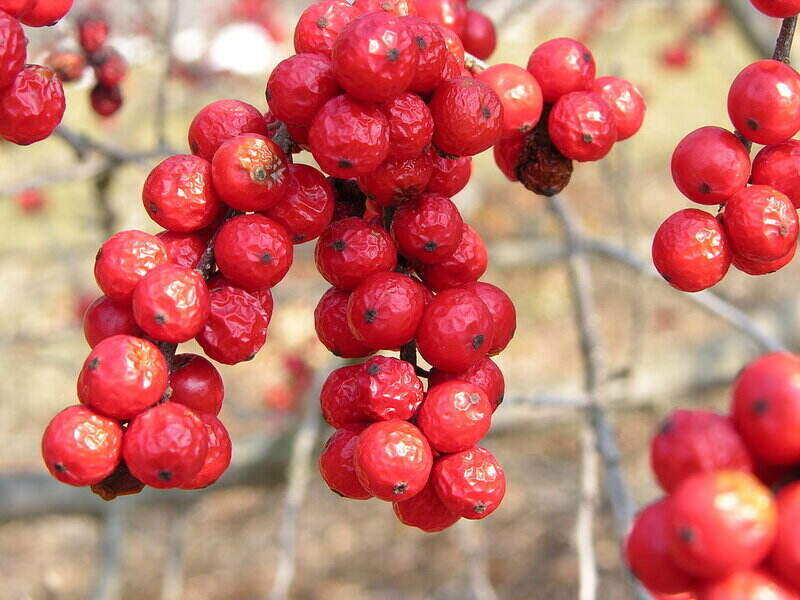
Photo Credit: Derek Ramsey / Wikimedia Commons / CC BY-SA 2.5
Winterberry is a deciduous tree in the holly family. This low-maintenance accent plant is often found near stream banks, ponds, and forest wetlands in the Nutmeg State. It grows well in mass plantings, shrub borders, wet soils, and near water.
Winterberry is the hardiest of all native hollies. Green and white-hued flowers bloom in June while some plants produce bright red berries in late summer that last through winter, attracting birds and wildlife. Winterberry is resistant to both pests and diseases.
Growth habit: Small tree or large shrub
USDA hardiness zone: 3-9
Mature size: 6-10 feet tall
Duration: Perennial
Foliage: Deciduous
Sunlight needs: Full sun to full shade; prefers partial shade
Soil preferences: Prefers moist, acidic, sand, loam, medium-loam, clay-loam, or clay soils
Water needs: High; ensure the soil is moist; water once per day during dry periods in spring and summer
Potential hazards: Moderate toxicity; fruits and foliage poisonous to humans
How to Choose Native Plants for Your Connecticut Yard
Native plants have specific needs depending on the type and species you select. Your yard has its own unique microclimate, and not all native plants will grow well in your landscape. Select plants suitable for the sun exposure, soil, and water capabilities of your landscape.
Connecticut sits in USDA Hardiness Zones 5b to 6b, indicating the coldest annual temperature is -15 to -10 degrees Fahrenheit in the northernmost portion of the state. The majority of the Nutmeg State falls within zone 6a, with coastal areas falling into zone 6b. Connecticut native plants are cold-hardy to the minimum temperature in the hardiness zones. Keep your zone in mind when selecting non-native plants for your landscape.
FAQ About Native Connecticut Plants
Plant deciduous plants and broadleaf evergreens in early spring after the last frost and conifers in early fall. Plant anytime during the frost-free Connecticut growing season from early May to mid-October.
Connecticut’s diverse landscape is home to many soil types including loose stones and gravel, rich saturated soils, alluvial sediments, disturbed loams, gravelly sand, and more. There are even areas of the state where solid bedrock lies just 2 to 3 feet below the surface.
The best way to identify your landscape’s soil type is to send a soil sample in for testing to your local testing laboratory.
Early morning is the best time to water your native plants. Winds are calmer and temperatures are lower, so there is less risk of water loss from evaporation or scorching from the sun. Additionally, foliage needs time to dry before nightfall. Wet foliage can lead to disease and rot.
Where to Find Native Plants in Connecticut
Chances are good you already have native plants in your yard or around your neighborhood. If you want to introduce more plants into your Connecticut landscape, be sure to source your plants ethically and never transplant them from the wild.
Filling your yard with native plants is only one step in your landscaping design project. Be sure to maintain your new landscape by understanding your yard’s grass type.
No matter where you are in the Nutmeg State, you can turn over your lawn upkeep to a professional. Let WikiLawn connect you with a local landscaping pro in your area so you can spend more time soaking up your state’s rich history.
Main Image Credit: Pxfuel